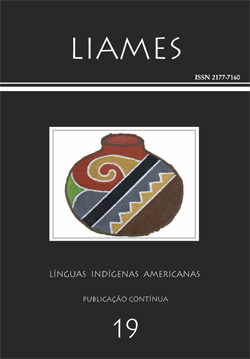Resumen
The Kampan languages have the grammatical feature called reality status, which consists of obligatory verbal affixes that express a binary opposition between realized and unrealized events. Although the validity of this grammatical category has been questioned for its lack of consistency cross-linguistically, the pan-Kampan system has been presented as an example of a canonical reality status opposition. This article examines and compares the almost identical reality status systems of all Kampan languages, and then, based on dedicated fieldwork, goes on to describe the change that Ucayali-Pajonal Ashéninka has undergone. This change consists in the loss of the reality status system in most I-class verbs, the largest by far of the two verb classes typical of Kampan languages, and makes Ucayali-Pajonal Ashéninka divergent in this aspect from the other Kampan languages. This loss shows a grammatical change taking place and therefore poses some questions about the evolution of such a grammatical feature, which are analyzed in the conclusions.
Citas
Base de Datos de Pueblos Indígenas u Originarios. Ministerio de Cultura del Perú. Retrieved from bdpi.cultura.gob.pe. Accessed 02/2018.
Bybee, Joan (1998). “Irrealis” as a grammatical category. Anthropological Linguistics 40(2): 257-271.
Bybee, Joan; Perkins, Revere; Pagliuca, William (1994). The evolution of grammar: tense, aspect and modality in the languages of the world. Chicago: University of Chicago Press.
De Haan, Ferdinand (2012). Irrealis: fact or fiction? Language Sciences 34(2): 107-130. doi: https://doi.org/10.1016/j.langsci.2011.06.016
García Salazar, Gabriela Victoria (1993). Ashéninca-Ucayali: morfología y fonología (Master thesis). Florionópolis: Universidade Federal de Santa Catarina.
García Salazar, Gabriela Victoria (1997). Generalidades de la morfología y la fonología del ashéninca del Ucayali. Revista Latinoamericana de Estudios Etnolingüísticos 9: 1-101.
Givón, T. (1994). Irrealis and the subjunctive. Studies in Language 18(2): 265-337. doi: https://doi.org/10.1075/sl.18.2.02giv
Gordon, Raymond G., Jr. (ed.) (2005). Ethnologue: languages of the world. Fifteenth edition. Dallas: SIL International. Retrieved from archive.ethnologue.com/15. Accessed in 04/2017.
Grimes, Barbara F. (ed.) (2000). Ethnologue: languages of the world. Fourteenth edition. Dallas SIL International. Retrieved from archive.ethnologue.com/14. Accessed in 04/2017.
Hammarström, Harald; Forkel, Robert; Haspelmath, Martin (2018). Glottolog 3.3. Jena: Max-Planck-Institut für Menschheitsgeschichte. Retrieved from glottolog.org. Accessed 10/2018.
Heitzman, Allene (1991). Tiempo y lugar en la narrativa del ashéninca pajonalino. Revista Latinoamericana de Estudios Etnolingüísticos 6: 113-132.
Lawrence, Aimee Lynn (2013). Inflectional verbal morphology in Nomatsigenga (Master thesis). Austin: University of Texas at Austin.
Michael, Lev (2008). Nanti evidential practice: Language, knowledge, and social action in an Amazonian society (doctoral dissertation). Austin: University of Texas at Austin.
Michael, Lev (2014). The Nanti reality status system: implications for the typological validity of the realis/irrealis contrast. Linguistic Typology 18(2): 251-288. doi: https://doi.org/10.1515/lingty-2014-0011
Mihas, Elena (2010). Essentials of Ashéninka Perené grammar (doctoral dissertation). Milwaukee: University of Wisconsin-Milwaukee.
Mihas, Elena (2015a). A grammar of Alto Perené (Arawak) (Mouton Grammar Library 69). Berlin: De Gruyter Mouton.
Mihas, Elena (2015b). Non-spatial setting in Satipo Ashaninka (Arawak). Talk given at the Round Table Meeting, LCRC (Language and Culture Research Centre, James Cook University), September 2.
Mithun, Marianne (1995). The relativity of irreality. In Joan Bybee; Suzanne Fleischman (eds.). Modality in grammar and discourse, pp. 367-388. Amsterdam: Benjamins.
Palmer, Frank R. (2001). Mood and modality. Cambridge: Cambridge University Press.
Payne, David L. (1981). The phonology and morphology of Axininca Campa (SIL Publications in Linguistics 66). Dallas: Summer Institute of Linguistics and University of Texas at Arlington.
Payne, David L. (1983). Notas morfológicas y morfofonémicas sobre el ashéninca del Pichis. In David L. Payne; Marlene Ballena Dávila (eds.). Estudios lingüísticos de textos ashéninca (campa-arawak preandino) (Serie Lingüística Peruana 21), pp. 101-112.
Payne, David L. (2001). Causatives in Asheninka: The case for a sociative source. In Masayoshi Shibatani (ed.). The grammar of causation and interpersonal manipulation (Typological Studies in Language, vol 48), pp. 485-505. Amsterdam: John Benjamins.
Payne, David L. & Judith K. Payne (1983). Análisis de un texto ashéninca: la inundación de la tierra. In David L. Payne; Marlene Ballena Dávila (eds.). Estudios lingüísticos de textos ashéninca (campa-arawak preandino) (Serie Lingüística Peruana 21), pp.113-164 .
Payne, David L.; Payne, Judith K.; Sánchez Santos, Jorge (1982). Morfología, fonología y fonética del ashéninca del Apurucayali (2nd edition). Lima: Instituto Lingüístico de Verano.
Pedrós, Toni (2018). Ashéninka y asháninka: ¿de cuántas lenguas hablamos? Cadernos de Etnolingüística vol. vol. 6(1): 1-30.
Simons, Gary F., & Charles D. Fennig (eds.) (2018). Ethnologue: languages of the world, twenty-first edition. Dallas: SIL International. Retrieved from www.ethnologue.com. Accessed in 03/2018.
Snell, Betty A. (2011). Diccionario matsigenka – castellano, con índice castellano, notas enciclopédicas y apuntes gramaticales. Lima: Instituto Lingüístico de Verano.
Swift, Kenneth E. (2008) [1988]. Morfología del caquinte, translated from English by Elena Townsend Díez-Canseco and Marlene Ballena Dávila (2nd edition) (Serie Lingüística Peruana nº 25). Lima: Instituto Lingüístico de Verano.
Wise, Mary Ruth. 1986. Grammatical characteristics of Pre-Andine Arawakan languages of Peru. In Desmond Derbyshire; Geoffrey K. Pullum (eds.). Handbook of Amazonian languages, vol. 1, pp. 567-642. Berlin: Mouton de Gruyter.
Zumaeta Rojas, Esaú (2012). Guía teórica. Idioma asháninka. Lima: Universidad Católica Sedes Sapientiae.
LIAMES: Lenguas Indígenas Americanas utiliza la licencia de Creative Commons (CC), preservando así la integridad de los artículos en ambiente de acceso abierto.


